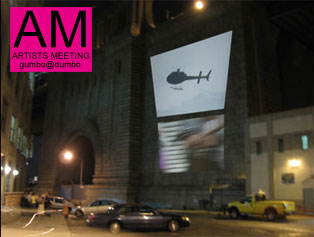MTAA-RR:
Sep 27, 2007
gumbo@dumbo
posted at 19:09 GMT by T.Whid in /news/twhid

G.H. Hovagimyan tells us…
gumbo@dumbopermanent link to this post
Art Under the Bridge Festival in Dumbo, Brooklyn
September 28, 29, 30th, 7pm to 11pm
Front Street & Adams Street, Brooklyn
Video Projection on the Manhattan Bridge Anchorage
I’ve been working with a group of artists over the summer. We have been finding ways to collaborate with each other through an open dialogue and discussion about art and group praxis. The name of the group is Artists Meeting;
Participating Artists include Leesa Abahuni, Nicole Abahuni, James Andrews, Daniel Blochwitz, Chris Borkowski, Ursula Endlicher, G.H. Hovagimyan, Thomas Hutchison, Lara Star Martini, Nsumi Group, [PAM], Joao Salema, Raphaele Shirley, Jason Wee, Lee Wells.
We will present our first public collaborative video installation this weekend at the Art Under the Bridge Festival in Dumbo, Brooklyn. We will project two 30 foot by 40 foot videos onto the south side of the Manhattan Bridge Anchorage from the loading dock just off the corner of Front and Adams.
‘Truth’ in photos?
posted at 01:11 GMT by T.Whid in /news/twhid
Two articles in today’s NYT provide a strange contrast to one another. The first is filmmaker Errol Morris’ essay regarding a photo from 1855 by Roger Fenton. (I had never heard of Fenton before today and had never seen the photos discussed.) And the second is an editorial criticizing the idea that the dunes that inspired Edward Hopper should be protected from development simply because they were inspirations to the artist.
First, in the Morris article, I find it bizarre that there is even a debate as to the worth of a photo (or the talent of the photographer) if the photo was somehow staged:
[Songtag] mentions how one of the Fenton photographs was posed or staged. That we’re always disappointed when we learn that a photograph has been posed. Then she goes on to talk about the difference between fake paintings and fake photographs. Namely, a fake painting is a painting with faulty provenance — say, a painting that is purportedly by Vermeer, but turns out to be painted by somebody else. But according to Sontag, a fake photograph is a photograph that’s been posed.
OK, for the layman, sure, they’re disappointed. But experts? Artists? They shouldn’t be disappointed because almost all photos are a fiction to one degree or another. This seems like a very important thing to recognize in this day in age because when people don’t realize this very simple concept things like this happen.
The second article makes more sense. It’s obvious that the landscape has been filtered through the artist. How could it not be? He painted it. Why do people persist in seeing art photos any differently? permanent link to this post
